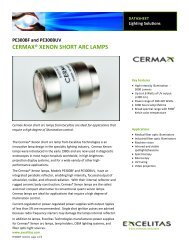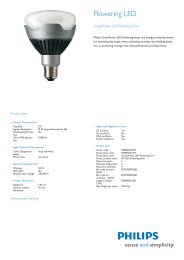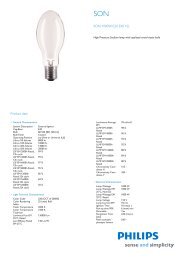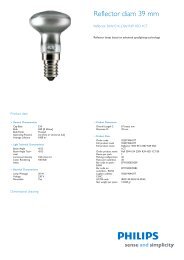Electronic ballasts for high-intensity discharge lamps Indoor HI PCI ...
Electronic ballasts for high-intensity discharge lamps Indoor HI PCI ...
Electronic ballasts for high-intensity discharge lamps Indoor HI PCI ...
You also want an ePaper? Increase the reach of your titles
YUMPU automatically turns print PDFs into web optimized ePapers that Google loves.
<strong>Electronic</strong> <strong>ballasts</strong> <strong>for</strong> <strong>high</strong>-<strong>intensity</strong> <strong>discharge</strong> <strong>lamps</strong><br />
<strong>Indoor</strong> <strong>HI</strong><br />
Multi wattage power selection<br />
The <strong>PCI</strong> PRO C011 are able to operate two different wattages. As a result of the<br />
lamp characteristics an automatic detection is not possible. The wattage selection<br />
is done via mains terminals. For using the lower power lamp connect the<br />
mains on the terminals [1] and [3]. For using the <strong>high</strong>er power lamp connect the<br />
mains on the terminals [2] and [3]. Do not connect the mains on the terminals<br />
[1] and [2] as this would destroy the device!<br />
To avoid the use of a wrong lamp we recommend to mark the luminaire with the<br />
correct lamp type.<br />
The unused multi wattage terminal [1] or [2] can lead mains voltage.<br />
Correct mains setup<br />
It is important to run the ballast only with the lamp set at the mains terminals.<br />
Over powering of the lamp will lead to a shorter lifetime or destruction of the<br />
lamp. Under powering may lead to an early shutdown or colour shifts in the lamp<br />
as well as a shorter life time.<br />
Note on <strong>PCI</strong> 20 / 22 PRO C011<br />
L<br />
N<br />
Pe<br />
x<br />
max. 5 kV<br />
20 W<br />
35 W<br />
100 W<br />
Circuit diagram multiwatt <strong>for</strong> 20, 35 and 100 W<br />
L<br />
N<br />
Pe<br />
1<br />
2<br />
3<br />
4<br />
5<br />
6<br />
8<br />
That ballast is designed to drive a standard 20 W lamp as well as 22 W <strong>lamps</strong>*.<br />
In this setup 20 W <strong>lamps</strong> cannot be ignited.<br />
* Philips CDM-TM 20<br />
x<br />
max. 5 kV<br />
1<br />
2<br />
3<br />
4<br />
5<br />
6<br />
8<br />
22 W<br />
50 W<br />
70 W<br />
150 W<br />
Circuit diagram multiwatt <strong>for</strong> 22, 50, 70 and 150 W<br />
Temperature range<br />
The ta temperature value is the basis <strong>for</strong> specifying<br />
the rated life.<br />
The relationship between the tc temperature and<br />
the ta temperature depends on the design of the<br />
luminaire. If the measured tc temperature is approximately<br />
5 K under the tc max. temperature the ta<br />
temperature should be checked and, if necessary,<br />
measurements should be taken on the critical components<br />
(e.g. electrolytic capacitor).<br />
Detailed in<strong>for</strong>mation is available on request.<br />
<strong>PCI</strong> PRO C011 is designed <strong>for</strong> an average life of<br />
50,000 hours under rated conditions, with a failure<br />
probability of less than 10 %. This corresponds to<br />
an average failure rate of 0.2 % per 1,000 hours of<br />
operation.<br />
The specified tc temperature is the maximum permitted<br />
value (rated temperature according to EN<br />
61347 -1). Above this safety-related value the thermal<br />
cutout protects the device against damage.<br />
The expected lifetime values are shown in the<br />
following table. The tc values are the relevant values<br />
here.<br />
Data sheet 04/12-835-6<br />
Subject to change without notice.<br />
www.tridonic.com 3










